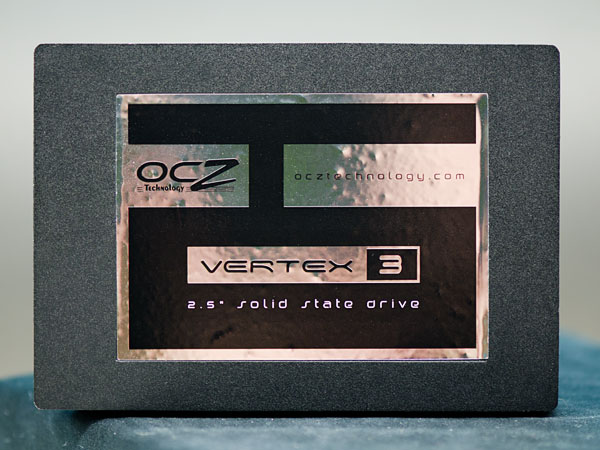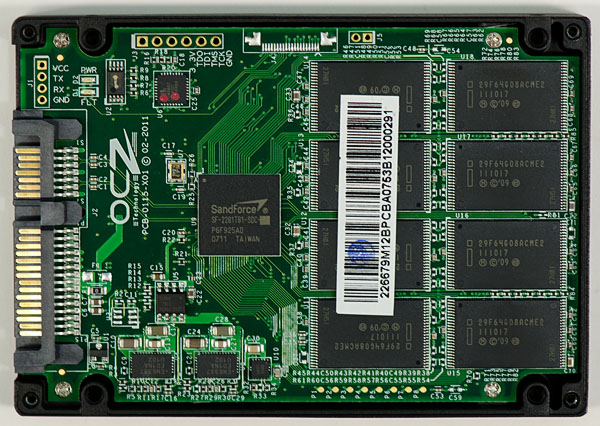The OCZ Vertex 3 Review (120GB)
by Anand Lal Shimpi on April 6, 2011 6:32 PM ESTThe Vertex 3 120GB
Whenever we review a new SSD many of you comment asking for performance of lower capacity drives. While we typically publish the specs for all of the drives in the lineup, we're usually only sampled a single capacity at launch. It's not usually the largest, but generally the second largest and definitely an indicator of the best performance you can expect to see from the family.
Just look at the reviews we've published this year alone:
Intel SSD 510 (240GB)
Intel SSD 320 (300GB)
Crucial m4 (256GB)
While we always request multiple capacities, it normally takes a little while for us to get those drives in.
When OCZ started manufacturing Vertex 3s for sale the first drives off of the line were 120GB, and thus the first shipping Vertex 3 we got our hands on was a more popular capacity. Sweet.
Let's first look at the expected performance differences between the 120GB Vertex 3 and the 240GB drive we previewed earlier this year:
| OCZ Vertex 3 Lineup | |||||
| Specs (6Gbps) | 120GB | 240GB | 480GB | ||
| Max Read | Up to 550MB/s | Up to 550MB/s | Up to 530MB/s | ||
| Max Write | Up to 500MB/s | Up to 520MB/s | Up to 450MB/s | ||
| 4KB Random Read | 20K IOPS | 40K IOPS | 50K IOPS | ||
| 4KB Random Write | 60K IOPS | 60K IOPS | 40K IOPS | ||
| MSRP | $249.99 | $499.99 | $1799.99 | ||
There's a slight drop in peak sequential performance and a big drop in random read speed. Remember our discussion of ratings from earlier? The Vertex 3 was of course rated before my recent conversations with OCZ, so we may not be getting the full picture here.
Inside the 120GB Vertex 3 are 16 Intel 25nm 64Gbit (8GB) NAND devices. Each device has a single 25nm 64Gbit die inside it, with the capacity of a single die reserved for RAISE in addition to the typical ~7% spare area.
The 240GB pre-production drive we previewed by comparison had twice as many 25nm die per package (2 x 64Gbit per NAND device vs. 1 x 64Gbit). If you read our SF-2000 launch article one of the major advantages of the SF-2000 controller has over its predecessor is the ability to activate twice as many NAND die at the same time. What does all of this mean for performance? We're about to find out.
RC or MP Firmware?
When the first SF-1500/1200 drives shipped last year they actually shipped with SandForce's release candidate (RC) firmware. Those who read initial coverage of the Corsair Force F100 drives learned that the hard way. Mass production (MP) firmware followed with bug fixes and threatened to change performance on some drives (the latter was resolved without anyone losing any performance thankfully).
Before we get to the Vertex 3 we have to talk a bit about how validation works with SandForce and its partners. Keep in mind that SandForce is still a pretty small company, so while it does a lot of testing and validation internally the company leans heavily on its partners to also shoulder the burden of validation. As a result drive/firmware validation is split among both SandForce and its partners. This approach allows SF drives to be validated heavier than if only one of the sides did all of the testing. While SandForce provides the original firmware, it's the partner's decision whether or not to ship drives based on how comfortable they feel with their validation. SandForce's validation suite includes both client and enterprise tests, which lengthens the validation time.
The shipping Vertex 3s are using RC firmware from SandForce, the MP label can't be assigned to anything that hasn't completely gone through SandForce's validation suite. However, SF assured me that there are no known issues that would preclude the Vertex 3 from being released today. From OCZ's perspective, the Vertex 3 is fully validated for client use (not enterprise). Some features (such as 0% over provisioning) aren't fully validated and thus are disabled in this release of the firmware. OCZ and SandForce both assure me that the SF-2200 has been through a much more strenuous validation process than anything before it.
Apparently the reason for OCZ missing the March launch timeframe for the Vertex 3 was a firmware bug that was discovered in validation that impacted 2011 MacBook Pro owners. Admittedly this has probably been the smoothest testing experience I've encountered with any newly launched SandForce drive, but there's still a lot of work to be done. Regardless of the performance results, if you want to be safe you'll want to wait before pulling the trigger on the Vertex 3. SandForce tells me that the only difference between RC and MP firmware this round is purely the amount of time spend in testing - there are no known issues for client drives. Even knowing that, these are still unproven drives - approach with caution.
The Test
| CPU |
Intel Core i7 965 running at 3.2GHz (Turbo & EIST Disabled) Intel Core i7 2600K running at 3.4GHz (Turbo & EIST Disabled) - for AT SB 2011, AS SSD & ATTO |
| Motherboard: |
Intel DX58SO (Intel X58) Intel H67 Motherboard |
| Chipset: |
Intel X58 + Marvell SATA 6Gbps PCIe Intel H67 |
| Chipset Drivers: |
Intel 9.1.1.1015 + Intel IMSM 8.9 Intel 9.1.1.1015 + Intel RST 10.2 |
| Memory: | Qimonda DDR3-1333 4 x 1GB (7-7-7-20) |
| Video Card: | eVGA GeForce GTX 285 |
| Video Drivers: | NVIDIA ForceWare 190.38 64-bit |
| Desktop Resolution: | 1920 x 1200 |
| OS: | Windows 7 x64 |












153 Comments
View All Comments
dagamer34 - Wednesday, April 6, 2011 - link
Any idea when these are going to ship out into the wild? I've got a 120GB Vertex 2 in my 2011 MacBook Pro that I'd love to stick into my Windows 7 HTPC so it's more responsive.Ethaniel - Wednesday, April 6, 2011 - link
I just love how Anand puts OCZ on the grill here. It seems they'll just have to step it up. I was expecting some huge numbers coming from the Vertex 3. So far, meh.softdrinkviking - Wednesday, April 6, 2011 - link
"OCZ insists that there's no difference between the Spectek stuff and standard Micron 25nm NAND"Except for the fact that Spectek is 34nm I am assuming?
There surely must be some significant difference in performance between 25 and 34, right?
softdrinkviking - Wednesday, April 6, 2011 - link
sorry, i think that wasn't clear.what i mean is that it seems like you are saying the difference in process nodes is purely related to capacity, but isn't there some performance advantage to going lower as well?
softdrinkviking - Wednesday, April 6, 2011 - link
okay. forget it. i looked back through and found the part where you write about the 25nm being slower.that's weird and backwards. i wonder why it gets slower as it get smaller, when cpus are supposedly going to get faster as the process gets smaller?
are their any semiconductor engineers reading this article who know?
are the fabs making some obvious choice which trades in performance at a reduced node for cost benefits, in an attempt to increase die capacities and lower end-user costs?
lunan - Thursday, April 7, 2011 - link
i think because the chip get larger but IO interface to the controller remain the same (the inner raid). instead of addressing 4GB of NAND, now one block may consists of 8GB or 16GB NAND.in case of 8 interface,
4x8GB =32GB NAND but 8x8GB=64GB NAND, 8x16GB=128GB NAND
the smaller the shrink is, the bigger the nand, but i think they still have 8 IO interface to the controller, hence the time takes also increased with every shrinkage.
CPU or GPU is quite different because they implement different IO controller. the base architecture actually changes to accommodate process shrink.
they should change the base architecture with every NAND if they wish to archive the same speed throughput, or add a second controller....
I think....i may not be right >_<
lunan - Thursday, April 7, 2011 - link
for example the vertex 3 have 8GB NAND with 16(8 front and 8 back) connection to the controller. now imagine if the NAND is 16GB or 32 GB and the interface is only 16 with 1 controller?maybe the CPU approach can be done to this problem. if you wish to duplicate performace and storage, you do dual core (which is 1 cpu core beside the other)....
again...maybe....
softdrinkviking - Friday, April 8, 2011 - link
thanks for your reply. when i read it, i didn't realize that those figures were referring to the capacity of the die.as soon as i re-read it, i also had the same reaction about redesigning the controller, it seems the obvious thing to do,
so i can't believe that the controller manufacturer's haven't thought of it.
there must be something holding them back, probably $$.
the major SSD players all appear to be trying to pull down the costs of drives to encourage widespread adoption.
perhaps this is being done at the expense of obvious performance increases?
Ammaross - Thursday, April 7, 2011 - link
I think if you re-reread (yes, twice), you'll note that with the die shrink, the block size was upped from 4K to 8K. This is twice the space to be programmed or erased per write. This is where the speed performance disappears, regardless of the number of dies in the drive.Anand Lal Shimpi - Wednesday, April 6, 2011 - link
Sorry I meant Micron 34nm NAND. Corrected :)Take care,
Anand